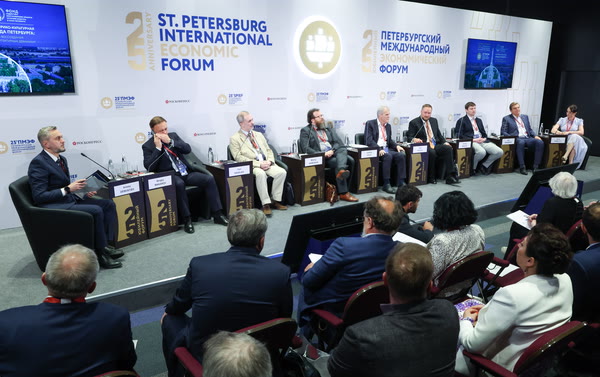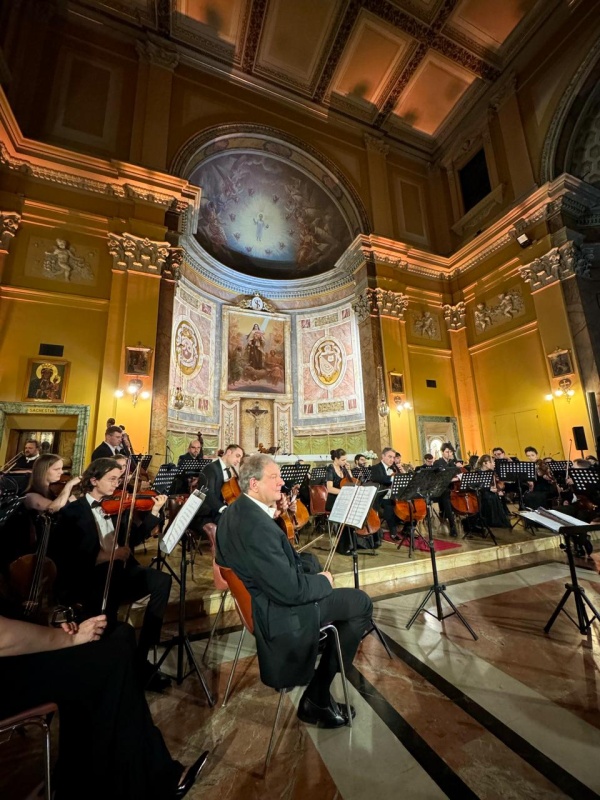
Urban Heritage: Rebuilding Architectural Dominants
KEY CONCLUSIONS
The city and government authorities are committed to the creation of architectural landmarks
“Are architectural landmarks important to St. Petersburg? Of course, nobody in this hall would raise their hand and say ‘No, I oppose this!’ Landmarks are of course needed, and I think that many of the architecture professionals here today remember the decree of Nicholas I forbidding the construction of buildings higher than the Winter Palace, except for churches. As a result, churches account for most of the city’s architectural landmarks. It is pointless to dispute the importance of creating an architectural landscape through buildings which rise above the overall structure of the city. These buildings are essential,” Sergey Makarov, Chairman of the Committee on State Control, Use and Protection of Historical and Cultural Monuments, St. Petersburg City Administration.
“Discussions on reconstructing architectural landmarks have been going on for quite a while, and we have lost a great many of them in our city [St. Petersburg – ed.]. We even have city law 820, which includes a list of lost landmarks put forward for reconstruction. So, overall, the city is pursuing a policy of ensuring there are architectural landmarks,” Sergey Makarov, Chairman of the Committee on State Control, Use and Protection of Historical and Cultural Monuments, St. Petersburg City Administration.
It is not only vital to reconstruct architectural landmarks, but to build new ones too
“Perhaps we should not only think about reconstructing, but also about creating new landmarks. <...> Perhaps urban development is also about constructing and creating something new, and not just rebuilding? In this sense, the Lakhta Center built by Gazprom – and everything around it – is an interesting development. What’s interesting is that it’s new, and led to the creation of new spaces,” Natalia Cherkesova, Deputy Chair, Union of Journalists of St. Petersburg.
St. Petersburg is renowned for its Baroque architecture
“It seems to me that we can talk as much as we like about the terminology of reconstruction. I think that what we’re focused on is the completion of Rastrelli’s phenomenal architectural ensemble. <...> This tower represents the culmination of St. Petersburg’s stucco Baroque era. However, it was not to be, unfortunately. <...> The world sees us [St. Petersburg – ed.] as a Baroque city – they are uninterested in everything else,” Mikhail Mamoshin, Academician of Architecture, Honoured Architect of Russia; Vice President, St. Petersburg Union of Architects.
“Baroque is even more characteristic of Russia’s capital than Neoclassicism, particularly under the rule of Elizaveta Petrovna. It was under her reign that Russia was recognized as an empire following the Seven Years’ War. To my mind, the creation of this bell tower [at Smolny Cathedral – ed.] represented Russia’s exalted status in the global hierarchy. So, by reconstructing this bell tower today, we are also restoring historical memory,” Yuri Saveliev, Professor of the Faculty of Art, Lomonosov Moscow State University; Professor, International Academy of Architecture in Moscow; Adviser, Russian Academy of Architecture and Construction Sciences; Member of the Russian Academy of Arts.
PROBLEMS
There are a number of legal impediments to reconstructing architectural landmarks in St. Petersburg
“Of course, there are a number of major legal impediments when it comes to restoring landmarks and constructing new buildings in the centre. For example, federal law prohibits construction on cultural heritage sites. In 2015 I spoke out against this ban, which I consider completely wrong. Not all projects are alike: some places are suitable for construction, others are not. I was criticized terribly. <...> There are landmarks which, according to their architectural characteristics, could absolutely be modified,” Sergey Makarov, Chairman of the Committee on State Control, Use and Protection of Historical and Cultural Monuments, St. Petersburg City Administration.
“On behalf of the government, we evaluated, among other things, the potential to provide a plot of land to implement an investment project to reconstruct the architectural landmark at Smolny Cathedral. Of course, I would now like to point out that there is currently no legal basis for building the structure. A large number of amendments will indeed have to be made in order to bring this project to life. That’s because it’s both a protected area, and is located on a cultural heritage site – Smolny Cathedral. <...> We need to discuss this, take a decision, consider public opinion, and only then take a final decision as to whether the structure can be built there,” Anna Isakova, Director, Investment Management.
“In principle, I would say that we probably need to have architectural landmarks. But first of all, there needs to be a legal basis for us to construct something. That’s because it [St. Petersburg – ed.] is a difficult city. Very often, developers can find that their good initiatives get tied up in the courts. Numerous investment projects get postponed due to this. So, in order to do something – something that may be particularly hard to discuss – we need to focus very hard on tackling the legal side of things,” Tatiana Novitskaya, Architect; General Director, Gorod.
The reconstruction of the bell tower at Smolny Cathedral appears to be a utopian idea
“The idea of the so-called reconstruction of the bell tower at Smolny Cathedral is a classic simulacrum. The thing is, there can be no talk of any reconstruction. <...> We’re talking about a new construction project based on an unrealized design by an outstanding architect 250 years after his death. In this regard, we not only need to talk about legal issues which currently prevent this. We also need to talk about the principles of protecting cultural heritage which are set out in international documents, as well as in our practice. There are absolutely no grounds for this structure to be built,” Alexander Kononov, Deputy Chair, St. Petersburg Branch of the Russian Society for the Protection of Historical and Cultural Monuments.
“Rastrelli himself stopped construction [of the bell tower at Smolny Cathedral – ed.] <...> because he was afraid that it would simply collapse. Even today, I have asked our constructors to estimate whether the brick lime mortar is weak. We have one hundred and something [metres – ed.]. They say that, ‘Well, it’ll probably collapse. <...> Regardless, it will never get past the government expert review – I can guarantee that’,” Nikita Yavein, Head, Studio 44 Architecture Bureau.
There are not enough schools in Russia specializing in the reconstruction of architectural monuments
“We are not perfectly replicating [the Baroque era – ed.], but we are learning to do so. However, if a specialist walks past, they will immediately see that today’s work – even in its best form – is redolent of the 21st century,” Nikita Yavein, Head, Studio 44 Architecture Bureau.
SOLUTIONS
The reconstruction of architectural landmarks in St. Petersburg is an important undertaking, both in terms of tourism, and heritage
“The preservation of cultural heritage is an extremely important matter for St. Petersburg, and without a doubt, shaping public opinion is integral to this. For anything – including the reconstruction of architectural landmarks – broad-based and public support is essential,” Anton Ivanov, Deputy Chairman, Russian Society for the Protection of Historical and Cultural Monuments.
“I can say that the reconstruction of the bell tower at Rastrelli’s Smolny Cathedral in St. Petersburg is a striking example of something which, through the addition of something new, could become a world-renowned tourist landmark – something appearing both fitting and relevant today. So, what’s left to say? It needs to be reconstructed,” Ljubisa Folic, Professor of Architecture, University of Pristina.
“It seems to me that creating these new stories is a very interesting and important thing to do. Yes, it’s difficult from a legal point of view, but I think that we need to leave something interesting behind for after we’re gone. People do become more conservative as they get older. However, St. Petersburg seems to me to be a progressive city, and if we manage to bring this project to life, I think it would be wonderful. St. Petersburg would gain something that people would come to see and recall the work that we are doing right now,” Maxim Meiksin, Vice Governor of St. Petersburg.
Legal issues surrounding the reconstruction of architectural landmarks can be resolved
“If expert and public opinion are both favourable to the idea of reconstructing this architectural ensemble [Smolny Cathedral – ed.], then I will absolutely be willing to join this undertaking and do everything I can to solve all the legal issues at the level of the federal government as fast as possible,” Igor Ananskikh, Deputy of the State Duma of the Russian Federation.
“Regarding the bell tower, ultimately, I think I’m inclined to say that it’s difficult to call it a reconstruction project when it never existed in the first place. And again, a construction project involving non-natural materials probably also raises a number of questions regarding the use of the classical term ‘reconstruction’. Should the bell tower be built? Absolutely! The question is where. I have an answer. <...> It could go next to the garden on the banks of the Neva – the bend of the Neva, <...> or it could go on the opposite side – on the banks of the Okhta River,” Vladimir Grigoriev, Honoured Architect of the Russian Federation.








